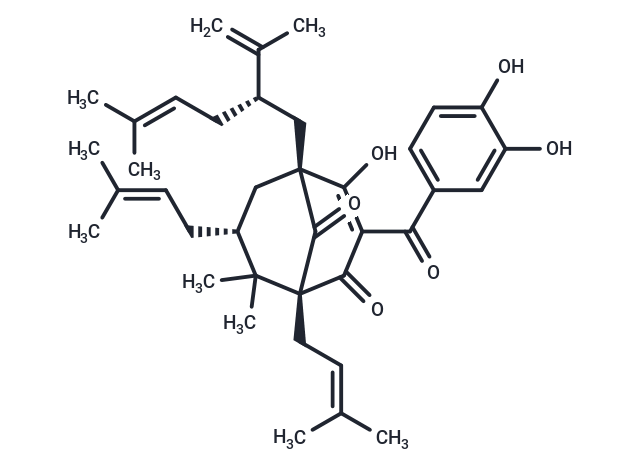Shopping Cart
Remove All Your shopping cart is currently empty
Your shopping cart is currently empty
Garcinol also inhibits histone acetyltransferases (HATs, IC50= 7 μM) and p300/CPB-associated factor (PCAF, IC50 = 5 μM). Garcinol has anti-inflammatory and anti-cancer activity. Garcinol, a polyisoprenylated benzophenone harvested from Garcinia indica, exerts anti-cholinesterase properties towards acetyl cholinesterase (AChE) and butyrylcholinesterase (BChE) with IC50s of 0.66 μM and 7.39 μM, respectively.

| Pack Size | Price | USA Warehouse | Global Warehouse | Quantity |
|---|---|---|---|---|
| 1 mg | $64 | - | In Stock | |
| 5 mg | $148 | - | In Stock | |
| 10 mg | $218 | - | In Stock |
| Description | Garcinol also inhibits histone acetyltransferases (HATs, IC50= 7 μM) and p300/CPB-associated factor (PCAF, IC50 = 5 μM). Garcinol has anti-inflammatory and anti-cancer activity. Garcinol, a polyisoprenylated benzophenone harvested from Garcinia indica, exerts anti-cholinesterase properties towards acetyl cholinesterase (AChE) and butyrylcholinesterase (BChE) with IC50s of 0.66 μM and 7.39 μM, respectively. |
| Targets&IC50 | AChE:0.66 µM , BChE:7.39 µM |
| In vitro | Garcinol (10-50 μM; 24-72 hours) induces apoptosis and inhibits the proliferation of HNSCC cells in a time- and dose-dependent manner, specifically in the cell lines CAL27 and UMSCC1. Additionally, Garcinol (50 μM; 1-6 hours) suppresses the phosphorylation and degradation of constitutive IκBα in a time-dependent manner. |
| In vivo | Garcinolinduces significant inhibition of tumor growth. |
| Molecular Weight | 602.8 |
| Formula | C38H50O6 |
| Cas No. | 78824-30-3 |
| Smiles | CC(C)=CC[C@@H](C[C@@]12C[C@@H](CC=C(C)C)C(C)(C)[C@@](CC=C(C)C)(C(=O)C(C(=O)c3ccc(O)c(O)c3)=C1O)C2=O)C(C)=C |
| Relative Density. | 1.114 g/cm3 (Predicted) |
| Color | White |
| Appearance | Solid |
| Storage | store at low temperature,keep away from direct sunlight | Powder: -20°C for 3 years | In solvent: -80°C for 1 year | Shipping with blue ice/Shipping at ambient temperature. | |||||||||||||||||||||||||
| Solubility Information | Ethanol: 20 mg/mL (33.18 mM), Sonication and heating are recommended. DMSO: 20 mg/mL (33.18 mM), Sonication and heating are recommended. | |||||||||||||||||||||||||
Solution Preparation Table | ||||||||||||||||||||||||||
Ethanol/DMSO
| ||||||||||||||||||||||||||
| Size | Quantity | Unit Price | Amount | Operation |
|---|

Copyright © 2015-2025 TargetMol Chemicals Inc. All Rights Reserved.